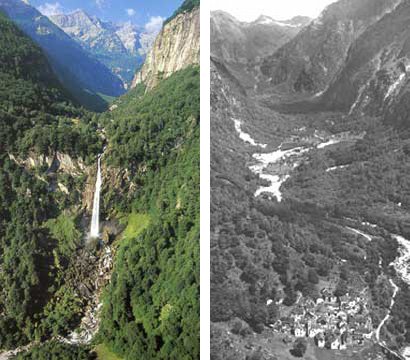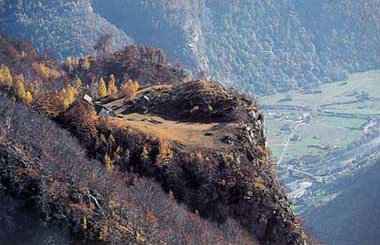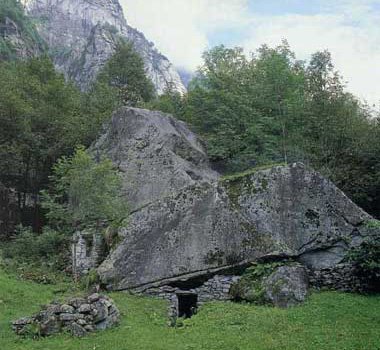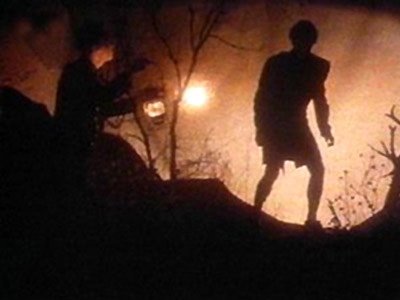Showing posts with label avalanche. Show all posts
Showing posts with label avalanche. Show all posts
Fred Astaire as Landscape Architecture
Imagine a mountain ex-urb of catching dams, deflection walls, earth sewers and mesh-bracketed hillside roads. Single-family deflection-dam houses with self-raking zen rock gardens. A fog of pulverized boulders billowing from the occasional rockslide giving the place a touch of the arcadian. Debris basins as community parks braceleted through a creeping city.
When the mountains have been denuded of vegetation and the torrents are on their way, everyone in this precarious city will go about their daily business as usual, sleep peacefully while boulders and mud flow around them. Should their homes topple when the ground beneath gives way, remember that all the buildings here were designed like earthbound space stations inhabited by floating astronauts, or Fred Astaire.
Soft Brackets
In case you need reminding, you now only have exactly one month to submit to Bracket 2.
Bracket 2 invites the submission of critical articles and unpublished design projects that investigate physical and virtual soft systems, as they pertain to infrastructure, ecologies, landscapes, environments, and networks. In an era of declared crises—economic, ecological and climatic amongst others—the notion of soft systems has gained increasing traction as a counterpoint to permanent, static and hard systems.
...
Bracket 2 seeks to critically position and define soft systems, in order to expand the scope and potential for new spatial networks, and new formats of architecture, urbanization and nature. From soft politics, soft power and soft spaces to fluid territories, software and soft programming, Bracket 2 questions the use and role of responsive, indeterminate, flexible, and immaterial systems in design.
And in case you've yet to begin work on your submission and need a starting point, check out these videos of landslides and the infrastructural counter-measures to mitigate and manage an ever shifting landscape.
Landslide Taxonomy

On the landslide taxonomy above, the British Geological Survey writes:
The main classification criteria are: type of movement (falls, topples, slides spreads, flows), and type of material involved in the movement (rock, debris, earth). Combining movement and material type terms enables an appropriately descriptive landslide name to be formulated. Naming can become more detailed with the addition of other descriptive details related to activity state, water content , rate of movement, etc., if known (e.g. active, complex, extremely rapid, dry rock fall-debris flow).
Only a small selection of the wide spectrum of landslide types that may develop in nature are shown here.
Surely the image needs to be accompanied by an illustrative taxonomy of mitigative measures against landslides showing a wide spectrum of programs and strategies for inhabiting the geological wilderness.
Disaster Tumuli

Inscribed on that liminal space where civilization messily interfaces with the wilderness is a series of monumental earthworks protecting the Icelandic town of Siglufjörður from snow avalanches and landslides.
While the planning and construction of these defense structures were the work of a multi-disciplanary team, for our own purposes, we'll concentrate on the contributions of the landscape architects involved in the project, specifically the Reykjavík-based firm of Landslag.


These anti-disaster tumuli were built in two phases. Completed in 1999, Phase I involved the construction of two deflecting dams on the south end of town. These direct avalanches from the most hazardous locations away from the populated area. The smaller of these dams, at 200m long and 15-16m high, is not as visible as the larger dam, which measures 700m long and 18m high and runs prominently up along the mountainside to an elevation of 180m.
Completed in 2008, Phase II involved the construction of 6 walls and dikes running along the entire mountainward side of Siglufjörður. Unlike the two deflecting dams built in Phase 1, these are intended to stop the flow of an avalanche rather than change its course.

During the early planning stages of the project, there were concerns about the negative social and even psychological impact of these massive landscape alterations on the town's residents, who, despite acknowledging their vital role in preventing fatalities and property damage, might nevertheless show strong resistance to such large-scale structures. This is where Landslag came in.
Working closely with the engineers, geophysicists and meteorologists, Landslag focused on minimizing the visual impact of the project. Their solution was to approach the structures not only as fortifications against nature but also as an opportunity to create recreational spaces out of the defensive infrastructure. They were turned into an architectural statement, a positive cultural asset rather than an invasive structure. Since these gigantic structures could never be hidden, nor could they be camouflaged from view with tall-growing trees, turning them into landmarks was very logical.

The avalanche defense structure, in fact, doubles as an outdoor recreational facility. Paths weave around the structures and run on top along their ridge lines, directing hikers up the mountain. Already these trails are heavily used. At the end of the larger deflecting dam is a sloping bastion used as a public viewing platform. It's a hazard zone, but they're also occupiable.


In order to avoid the deflecting walls from looking too dominating, they were designed to mimic the natural features of the surrounding landscapes. With the additional use of natural materials, their organic, undulating forms help to blend them into the landscape. To even further soften their substantial profiles, a process has been started which in decades to come will see the natural vegetation of the area reclaim and inhabit it once again.

It is worth contrasting these with the avalanche protection structures at Drangagil Neskaupstaður and Flateyri, which look like they belong more to a Medieval walled city.
Gazex®
Wearable Anti-Avalanche Homes
Sites of Managed Anxiety
Gazex®

Several memes running through this blog come wonderfully together in Gazex®, an anti-avalanche system manufactured by Technologie Alpine de Sécurité (TAS): terrestrial augments, wilderness access, urban/wild interface, disaster urbanism, climate change and (admittedly a stretch) fountains.

From a distance, they look like disembodied talons jutting out from the rockface, ready to prick at imminent disasters. With their array of remote sensors, they are constantly reading the landscape; the mountains are kept under constant surveillance, lest they want to endanger quaint Alpine hamlets and new luxury ski resort developments above Denver or lose skiers to the wintry wilds.
When an avalanche is deemed likely, it detonates a mixture of oxygen and propane gas in its explosion chamber. The resulting hot gas is then directed downwards to the zone at risk.

TAS describes their product as the best avalanche prevention mechanism, as there are “no explosives to handle and no personnel interventions in or near danger zones.” But will there be any market for it in the near future? At least in the Alps, demand may soon vanish due to “a change in the large-scale weather pattern.”
From New Scientist:
In the late 1980s, there was a dramatic step-like drop in the amount of snow falling in the Swiss Alps. Since then, snowfall has never recovered. In some years, the amount that fell on the plateau between Zurich, Bern and Basel was 60 per cent lower than was typical in the early 1980s, says Christoph Marty at the Swiss Federal Institute for Snow and Avalanche Research in Davos. He has analysed snowfall trends spanning 60 years and adds that the average number of snow days over the last 20 winters is lower than at any time since records began more than 100 years ago.
The future of winter tourism in the region is looking grim.
Maybe TAS should start manufacturing artificial snow machines? Preferably not.

Should you want to see it in action, you can download this video. There is another, but that file may be corrupt, as it won't unzip for us.

It's the new version of Geoff's Earth-Fountain©, the present memorial to a vanishing landscape and the future memorial to an extinct one. Depending on who you ask, that bang echoing through the valley will be regarded as a mournful wail or a joyful bellow heralding the arrival of something new.
Drangagil Neskaupstaður
Sites of Managed Anxiety
Wearable Anti-Avalanche Homes
Image of the (Leap Year) Day

The anxious terrain of Drangagil Neskaupstaður in the east fjords of Iceland — where catching dams, braking mounds, deflection earthen walls, diversionary canals and other tectonic reconfigurations of the earth's surface lay waiting in the summer for winter's snow.
They're avalanche protection structures, but they may as well be MOUT facilities where landscape architects are trained to deal with future disasters that may or may not come; a new subgenre of public art; or the shooting location for Guy Maddin's sequel to Careful.
Wearable Anti-Avalanche Homes
Sites of Managed Anxiety
Wearable Anti-Avalanche Homes

Speaking of avant-garde wear, the Swiss company, Snowpulse, is selling an avalanche protection gear that can protect skiers and general hikers if they happen to get attacked by a mountain.
Following are some of their selling points:
Similarly to a life-jacket used in the sea, the Life Bag keeps you on your back and your head out of the snow. It’s the best solution to avoid being asphyxiated.
Snowpulse airbags offer a high added value option: the automatic deflation of your airbag. The airbag deflation creates a cavity around the victim. This cavity is a real help to extract the victim and also provides 150 Liters of air to breath if you are buried. Survival time is therefore drastically increased.
Up to 20% of avalanche deaths are due to traumas. Snowpulse airbags are the only one designed to protect your head and thorax against shocks.
What the company should manufacture next is a model that can increase survivability if you happen to be buried in a hundred feet of snow and perhaps at a deeper stratum.
Let's say you and your adventure buddies are traversing a little explored valley in the Rockies. The snow is freshly fallen, the smell of pine perfumes the air, the sun gently pricking your frozen cheeks. And then you hear a low rumbling sound, and it's getting louder and louder. But even before you notice that an avalanche is racing towards you, the motion detectors built into your Life Bags Xtreme® automatically trigger rapid inflation so that in nanoseconds you are enveloped in a protective bubble stocked with supplies to last weeks. Your companions, too, are safely domiciled inside their own caverns, to which your wearable anti-avalanche home plugs in instinctively with filamental tunnels. Under all that snow, a quaint mountain hamlet forms.
And perhaps this has been planned all along. You're a new breed of extreme property developers intent on developing a new ex-urb of Denver located deep in the wilderness. Avalanche urbanism.
Or: you're hiking through parched landscapes on the periphery of Los Angeles. And as predicted by FEMA, a perfect firestorm appears from behind a ridge, soon to engulf you and your companions. Of course, no one panics, because everyone's wearable anti-wildfire homes swell to form a protective bubble filled with supercooled air. And since there's a minibar, everyone waits out the fires.
Through insulated windows, you see a cinematic struggle better than what is shown at a theater on Hollywood Boulevard. Disaster tourism.
One even swears that he's on the surface of the sun.
Others think that they're experiencing some sort of therapeutic cleansing. It's the new California spa town: mobile, ridiculously trendy and a passing fad.
Sites of Managed Anxiety
Wearable Homes
Sites of Managed Anxiety

The beautiful rhyming scheme of anti-avalanche fences, or mountain implants, as photographed by Lois Hechenblaikner.



Which remind us that we are still waiting to hear of a competition for a new ex-urb community development sited, as per international trend, deep into the wilderness, and programmed to co-exist successfully with wildfires, 100-year floods, rock falls, outbreaks of new super-viruses, snow avalanches, or some other human-induced disasters.
“How deeply am I willing to go into the wilderness?”
Val Bavona
A couple of weeks ago and without much fanfare, as can be discerned from my end of the world, an entire Swiss valley was awarded the 17th International Carlo Scarpa Prize for Gardens. The prize, which is awarded by the Fondazione Benetton Studi Ricerche, recognizes responsible long-term stewardship of landscapes rich in natural and historical values.

Val Bavona is a “short, rugged valley high in the mountains of Canton Ticino, Switzerland, an 'awesomely beautiful' place, gouged by the glacier, shaped by water and stone, in which a community (about a thousand people) has come to terms with the power and harshness of nature and over time has developed the ideas, the attitudes, the actions and the artefacts of human life when pushed to its limits.”
And furthermore, the community of Val Bavona “continues to celebrate the beauty of a lifestyle reduced to essentials (houses still do without electricity) as a real utopia, a simple, practical way of continuing, conserving and innovating the resolute search for living space that has characterized its history, finding a use even for the great rocks dislodged in landslides by using the earth they brought down with them to create fragments of vegetable garden and pasture or by the exploitation of jagged ravines to make grondàn, cantìn and splüi.”


And here I'm inexplicably forced to mention the movie Careful by Guy Maddin. Set in an Alpine village tucked inside a valley perhaps not unlike Val Bavona, everyone must speak in whispers and suppress all loud noises — the cries of a baby, the bleatings of goats, even coitus — lest they want to set off a deadly avalanche.
These forced propriety and decorum, however, lead to emotional repression. Here, landscape nurtures a lurid, baroque internal pathology which outwardly manifests itself into incestuous desires, suicide, self-mutilation and murder.
And some people say Sick Building Syndrome is bad?

I am hardly saying that incest occurs at all at Val Bavona, and would only be speculating if I were to suggest that it may have ran rampant in the past, caused by anxieties over jagged ravines or impending landslides and secretly carried out in any one of the many colloquial architecture.
I am, however, wondering if there are landscapes somewhere else that can induce such aberrant pathology, landscapes that are the antithesis of Healing Gardens.
Or how about landscapes that somehow have been transformed by pathology. Are prairie restorations, for instance, the result of a self-perpetuating quest for redemption? I'm sure that visiting a patch of prairie, reconstructed or otherwise, can result in a prolonged irrational dependence on Claritin.
(I'm forced again to mention another movie here — Safe by Todd Haynes.)
So if after visiting a site by Ken Smith or Martha Schwartz or Peter Walker and you started having migraines, nose bleeds, or seizures, let us know. And if any doctor consultation and expensive therapies failed to treat your symptoms, after which you joined a cult-like desert commune and now spend your nights holed up in a futuristic igloo isolation chamber, let us know about that, too. Or better yet, start a blog, and we'll link to each and every one of your posts.

Val Bavona is a “short, rugged valley high in the mountains of Canton Ticino, Switzerland, an 'awesomely beautiful' place, gouged by the glacier, shaped by water and stone, in which a community (about a thousand people) has come to terms with the power and harshness of nature and over time has developed the ideas, the attitudes, the actions and the artefacts of human life when pushed to its limits.”
And furthermore, the community of Val Bavona “continues to celebrate the beauty of a lifestyle reduced to essentials (houses still do without electricity) as a real utopia, a simple, practical way of continuing, conserving and innovating the resolute search for living space that has characterized its history, finding a use even for the great rocks dislodged in landslides by using the earth they brought down with them to create fragments of vegetable garden and pasture or by the exploitation of jagged ravines to make grondàn, cantìn and splüi.”


And here I'm inexplicably forced to mention the movie Careful by Guy Maddin. Set in an Alpine village tucked inside a valley perhaps not unlike Val Bavona, everyone must speak in whispers and suppress all loud noises — the cries of a baby, the bleatings of goats, even coitus — lest they want to set off a deadly avalanche.
These forced propriety and decorum, however, lead to emotional repression. Here, landscape nurtures a lurid, baroque internal pathology which outwardly manifests itself into incestuous desires, suicide, self-mutilation and murder.
And some people say Sick Building Syndrome is bad?

I am hardly saying that incest occurs at all at Val Bavona, and would only be speculating if I were to suggest that it may have ran rampant in the past, caused by anxieties over jagged ravines or impending landslides and secretly carried out in any one of the many colloquial architecture.
I am, however, wondering if there are landscapes somewhere else that can induce such aberrant pathology, landscapes that are the antithesis of Healing Gardens.
Or how about landscapes that somehow have been transformed by pathology. Are prairie restorations, for instance, the result of a self-perpetuating quest for redemption? I'm sure that visiting a patch of prairie, reconstructed or otherwise, can result in a prolonged irrational dependence on Claritin.
(I'm forced again to mention another movie here — Safe by Todd Haynes.)
So if after visiting a site by Ken Smith or Martha Schwartz or Peter Walker and you started having migraines, nose bleeds, or seizures, let us know. And if any doctor consultation and expensive therapies failed to treat your symptoms, after which you joined a cult-like desert commune and now spend your nights holed up in a futuristic igloo isolation chamber, let us know about that, too. Or better yet, start a blog, and we'll link to each and every one of your posts.
Subscribe to:
Posts (Atom)